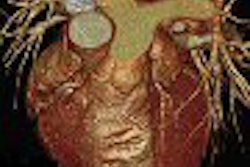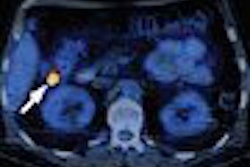Computer-aided detection (CAD) systems can aid in finding lung lesions missed at routine clinical interpretation, according to an article in the September issue of Chest.
"Beneficial integration of such systems into the clinical environment may therefore better ensure that patients with suspected thoracic disease are correctly classified and receive appropriate diagnostic workup and therapy," wrote a research team from Brigham & Women's Hospital in Boston, the University of Munich in Germany, and the Medical University of South Carolina (MUSC) in Charleston.
To assess the performance of a CAD system as a second reader on chest CT studies interpreted as normal at routine clinical interpretation, the researchers included 100 patients at one of two academic tertiary referral centers (Chest, Vol. 128:3 pp. 1517-1523). Chest CT studies were performed on the patients, who had results initially reported as normal at clinical double reading.
Chest CT indications were pulmonary embolism (33 patients), lung cancer screening in a high-risk population (28 patients), or follow-up for a history of cancer (39 patients). All chest CT studies were re-evaluated with the ImageChecker CT CAD system (R2 Technology, Sunnyvale, CA).
Two experienced radiologists then jointly evaluated and rated each CAD-marked image, with a third experienced radiologist serving as an adjudicator for equivocal cases. Each CAD mark was analyzed and confirmed or dismissed as a lung lesion. The lesions were classified, with the significant lung lesions classified by size: high (diameter ≥ 10 mm), intermediate (5-9 mm), and low (≤ 4 mm).
From all of the patients, the CAD system marked 285 image features, and detected significant lung lesions previously unreported in 33 of the 100 patients (33%). Fifty-three lesions were deemed to be significant, of which five (9.4%) were of high significance.
Twenty-one lesions (39.6%) were considered of intermediate significance, and 27 lesions (50.9%) were found to be of low significance. Nineteen patients had at least one lesion of high significance or one of high or intermediate significance, according to the study team.
Four patients (12.1%) in the pulmonary embolism group and six patients (21.4%) in the lung cancer group had focal lung lesions of high and/or intermediate significance. Nine patients (23.1%) in the group with a history of cancer had lesions of high and/or intermediate significance.
A total of 125 CAD marks were dismissed as false-positive findings, for an average of 1.25 per case (range 0 to 11).
"The vast majority of false-positive findings occurred at vessel crossings or vascular structures distorted by image artifacts due to motion (e.g., cardiac pulsation)," the authors wrote.
The study team noted that the false-positive rate was substantially less than with previous iterations of CAD algorithms.
"However, deployment of a false-positive detection mark in normal thoracic anatomy without pathologic correlate still requires an active decision from the interpreting physician to discard the mark," the study team wrote. "Dismissal of these detection marks as false-positive findings is usually not very challenging, and is accomplished by a single glance of a somewhat experienced reader."
By Erik L. Ridley
AuntMinnie.com staff writer
September 15, 2005
Related Reading
Despite flaws, lung CAD earns second-reader role, September 5, 2005
Management strategies evolve as CT finds more lung nodules, August 19, 2005
Part II: Computer-aided detection identifying new targets, July 15, 2005
CARS panel discusses the future of CAD, June 28, 2005
3D diminution index spots lung nodules attached to blood vessels, June 27, 2005
Copyright © 2005 AuntMinnie.com





















